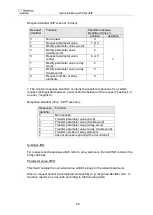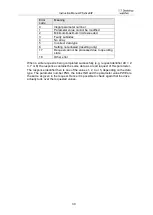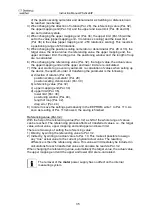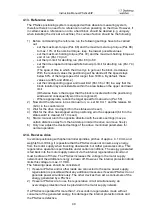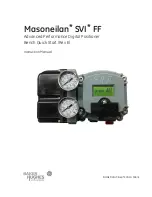
Instruction Manual PSx3xxEIP
35
of the position scaling numerator and denominator a stretching or distension can
be reached (see below).
3) When changing the direction of rotation (Par. 26), the referencing value (Par. 32),
the upper mapping end (Par. 34) and the upper and lower limit (Par. 36 and 38)
are set to delivery state.
4) When changing the upper mapping end (Par. 34), the upper limit (Par. 36) will be
set to the value [upper mapping end - 3 rotations x scaling] and the lower limit
(Par. 38) to the value [upper mapping end - 253 rotations x scaling]. This results in
a positioning range of 250 rotations.
5) When changing the position scaling numerator or denominator (Par. 28 or 30), the
target value, the actual value, the referencing value, the upper mapping end, the
upper and lower limit, the drag error, the positioning window and the length of loop
are re-calculated.
6) When changing the referencing value (Par. 32), the target value, the actual value,
the upper mapping end and the upper and lower limit are re-calculated.
7) If the user wants to go over any automatic re-calculation of values when setting up
the device, the optimum order of transfering the parameter is the following:
a) direction of rotation (Par. 26),
position scaling, numerator (Par. 28),
position scaling, denominator (Par. 30)
b) referencing value (Par. 32)
c) upper mapping end (Par. 34)
d) upper limit (Par. 36),
lower limit (Par. 38),
positioning window (Par. 40),
length of loop (Par. 42),
drag error (Par. 44)
8) In order to save the settings permanently in the EEPROM, write 1 to Par. 113. As
soon as reading of Par. 113 shows 0, the saving is finished.
Referencing value (Par. 32):
With the help of the referencing value (Par. 32) a shift of the whole range of values
can be reached. The referencing process affects all transferred values, i.e., the target
value, actual value, upper mapping end and upper and lower limit.
There are two ways of setting the referencing value:
1) Directly, by writing the referencing value to Par. 32.
2) Indirectly, by writing an actual value to Par. 10. This makes it possible to assign
any “true” actual value to the current, physical actual value. The resulting
difference is then the referencing value. This value will immediately be included in
calculations for each transferred value and can also be read via Par. 32.
When changing the referencing value, automatically the target value, the actual value,
the upper mapping end and the upper and lower limit are re-calculated.
The removal of the
motor
power supply has no affect on the internal
measuring system.









